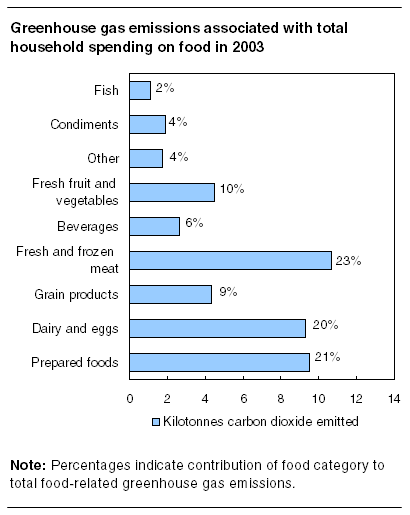Common menu bar links
Human Activity and the Environment: Food in Canada
Archived Content
Information identified as archived is provided for reference, research or recordkeeping purposes. It is not subject to the Government of Canada Web Standards and has not been altered or updated since it was archived. Please "contact us" to request a format other than those available.
Spending on food and non-alcoholic beverages in 2003 resulted in almost 46,000 kilotonnes of greenhouse gases, according to the first comprehensive national estimate of food-related greenhouse gas (GHG) emissions in Canada. This was equivalent to 6.4% of total national GHG emissions that year.
This national estimate was the result of integrating the most recent detailed data on the structure of the economy with data on energy use and GHG emissions.
Almost one-quarter (23%) of these food-related GHG emissions was attributable to the production of fresh and frozen meat, while fish products contributed 2%. Beef alone accounted for 15% of all GHG emissions resulting from household spending on food in 2003.

Looking at the amount of energy required to produce food shows another dimension of the environmental impact of the food system. More energy was used in the production of prepared foods than any of the other food groups, reflecting the energy inputs required for processing these foods. Prepared foods accounted for 19% of food-related energy use, while dairy and eggs accounted for 18%, and fresh and frozen meat accounted for 14%.
Farmers influence energy use through their choice of land management practices. The proportion of land prepared for seeding using no tillage increased from 6% of total area in 1991 to 46% in 2006. The share of land under conventional tillage fell from 69% to 28%.
In 2006, spending on fuel per hectare by farmers who used no tillage was about one-third that of spending by farmers who used conventional tillage. This reduction in fuel use also reduces air pollution and GHG emissions.
People are purchasing more food and beverages than they used to. Since 1976, the average number of calories available per person per day has increased 9% from 3,118 to 3,384 kilocalories. A lot of this food is not eaten. Waste occurs from spoilage and other losses in stores, restaurants and in the home.
In 2007, an estimated 38% of solid food available for retail sale was wasted, the equivalent of 183 kilograms per person. A decrease in food waste would reduce negative environmental impacts associated with food production, processing, distribution and services.
Canadians, who represent about 0.5% of the global population, produce about 1.5% of the food in the world and consume about 0.6% of world food production.
According to the Survey of Household Spending, Canadians allocated 15% of their household income to food in 2005, a lower proportion than in other countries. For example, Americans allocated 16% of their income to food, while people in France allocated 24% and the Chinese, 41%.
Note: This release is based on the feature article "Food in Canada" published today in Human Activity and the Environment: Annual Statistics. The article assesses the impact of the food system on the environment. Data used in the section on energy and greenhouse gas emissions involved in the production of food for households were derived from Statistics Canada's Material and Energy Flow Accounts.
These accounts integrate environmental data with economic data from Canada's System of National Accounts. One of the main components of the National Accounts are the input-output accounts, which produce highly detailed production and consumption statistics for 303 industries, 719 goods and services and 170 categories of final demand.
Definitions, data sources and methods: survey number 5115.
The publication Human Activity and the Environment: Annual Statistics, 2009 (16-201-X, free), is now available from the Publications module of our website. A printed version (16-201-X, $68) will soon be available.
For more information, or to enquire about the concepts, methods or data quality of this release, contact the Information Officer (613-951-0297; fax: 613-951-0634; environ@statcan.gc.ca), Environment Accounts and Statistics Division.

